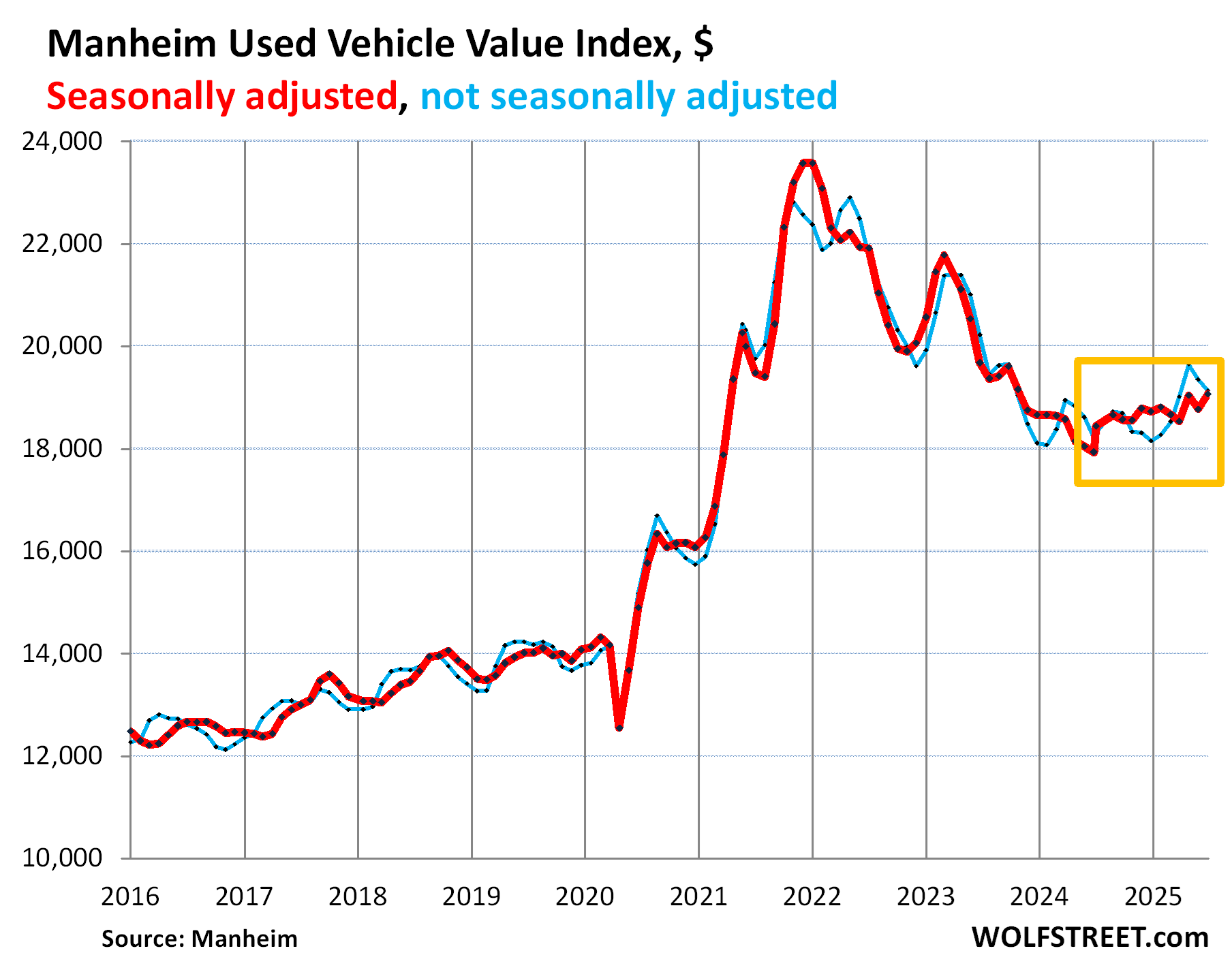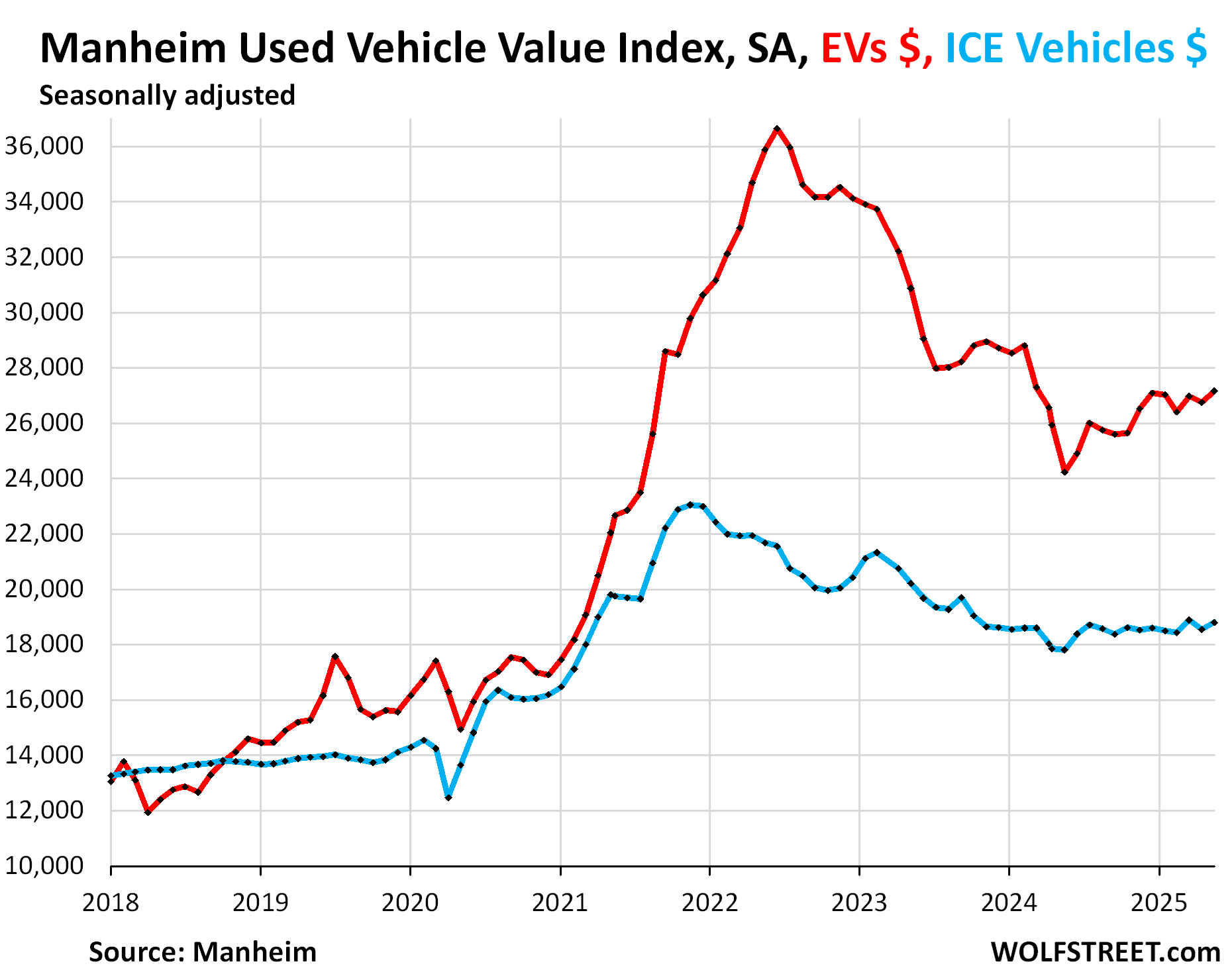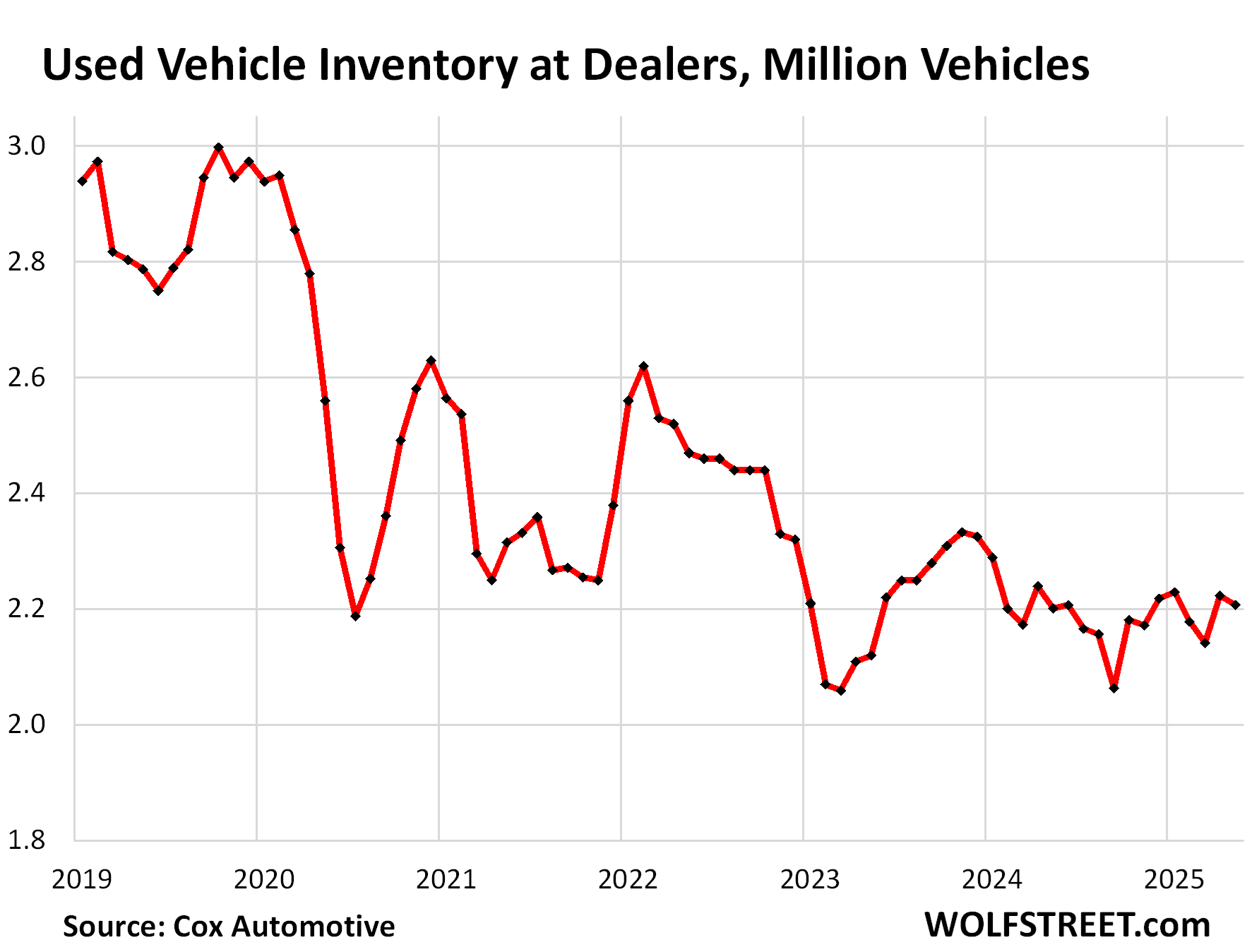Amid tight supply and solid demand.
By Wolf Richter for WOLF STREET.
Inflation pressures in used vehicle prices, after the historic plunge from the historic spike, have now been rebuilding for an entire year.
Prices of used vehicles sold at auctions where franchised and independent dealers replenish their inventories jumped by 1.6% in June from May, and were up by 6.3% year-over-year, seasonally adjusted (red line). Not seasonally adjusted, prices were up by 5.1% year-over-year (blue line).
These year-over-year price increases, which began in November 2024, were the biggest since mid-2022 when the historic price spike petered out.

The data is from today’s Used Vehicle Value Index by Manheim, the largest auto auction house in the US, and a unit of Cox Automotive. The index is adjusted for changes in mix and mileage.
Supply at these auctions comes from rental fleets that sell vehicles they pulled out of service, from finance companies that sell their off-lease vehicles and repos, from corporate and government fleets, other dealers, etc. These prices are the costs for dealers. Prices that consumers pay when they buy from dealers, as tracked by the used-vehicle CPI, follow these wholesale prices with a lag.
Some of the price pressures come from EVs.
Used EV wholesale prices have been ratcheting higher for a year at a substantial rate, and in June were up by 12.1% year-over-year seasonally adjusted, and by 9.8% not seasonally adjusted, according to the data from Manheim.
Prices of used vehicles with internal combustion engines (ICE) were up year-over-year by 5.6% seasonally adjusted, and by 4.5% not seasonally adjusted.
Both EV and ICE-vehicle year-over-year price increases in June were the hottest since mid-2022, but EV prices increased by over double the rate of ICE vehicle prices.
EVs are still a small but rapidly growing segment of what’s going through auctions, supplied mostly by lease returns and rental fleets.

Amid tight inventories and solid demand.
“Even so, retail sales continue to run a bit hotter than prior years, and off-lease supply into the market is still on a downward path, two factors which should be fairly supportive of higher values as we move onward,” Manheim said.
Retail inventories are tight amid supply constraints from off-lease vehicles and solid demand. The inventory at used-vehicle dealers at the end of May (latest data available from Cox Automotive) ticked down to 2.21 million units, roughly flat year-over-year, amid higher sales, and down by about 20% from the same period in 2019.

Influx into the used vehicle market comes from vehicles that had been purchased new some time ago. They enter the used market via trade-ins, lease returns, fleet turnover such as at rental operations (2.5 to 3.5 million vehicles in a normal year), etc.
The influx of supply into the used-vehicle market is still seeing the effects of the semiconductor shortages in 2021 and 2022 that had caused global vehicle production to plunge. In the US, 6 to 10 million fewer new-vehicles were sold over the two-year period than might have been otherwise, and these 6-10 million vehicles are now missing, and are not entering the supply pipeline of used vehicles.
As part of this scenario, leasing activity plunged during this time, and so the number of leases that have been maturing recently has been way down, and so supply from leasing companies, when they sell the two and three-year-old off-lease vehicles at auctions, has plunged. This may drag into 2026. And if demand remains solid amid tight inventory, prices will continue to feel the heat.
Enjoy reading WOLF STREET and want to support it? You can donate. I appreciate it immensely. Click on the mug to find out how:
![]()


I’ve wondered if the auto makers were going to come close to fulfilling their goal of keeping supplies really constrained after the Covid years. It appears to me that it’s a bit of forest vs. trees problem. If you look at certain brands/models, there is an over supply, but the charts posted here indicate that we have yet to completely return to the “before days”.
I’m just hoping I can nurse my aging fleet along for another few years in the hopes that the models I want that currently have a too-tight supply will become more readily available.
Do we know what percentage of used car sales go through the wholesale/retail channel versus person-to-person sales (Craigslist, eBay Motors, etc)? I’d be curious to know if that is changing over time.
These sales here are wholesale (auctions) = supply to dealers which then sell to retail customers. This has nothing to do with person-to-person sales.
There are close to 20 million used-vehicle wholesales in a decent year; and close 20 million used-vehicle retail sales by dealers in a decent year. The industry adds these up, and it comes out to be about 38-39 million used vehicle transactions. Note that this includes some vehicles with multiple transactions… a used vehicle can change hands three times in a few months, no problem (1. customer trades it in; 2. dealer sells it wholesale to another dealer; 3. that dealer sells it retail to a retail customer).
In a few years before the pandemic, used-vehicle transactions by dealers and auctions hit 40 million-plus.
I got a low mileage 3-year old used EV last year for around 1/4 it’s original list price after rebates and credits when stuff was cheap in 2024. Saves me around a grand on fuel. These things fall off the depreciation cliff fast.
Was a good deal while it lasted.
1/4 retail new EV greater buy ! Wolf you predicted the rise which hits inflation 4 years ago with the plunge in new car supply and the lack of rental fleet supply.
Inflation will remain sticky with these rising used car prices .
You have a terrific mind with long term cascading influences on the economic data that drives much of our economy.thanks for them insight
The dollar is having its worst year since Nixon. Why it will get even weaker in the days and months ahead.
MW: Home sellers have gotten tired of cutting prices. So they’re yanking their houses off the market.
Yes, sell them later for even less?
Perhaps, but many are doing unpublished ‘pocket listings’ with realtors like Compass searching for the ‘right’ wealthy buyer at the ‘right’ desired price and this is working to get higher prices when that ‘right’ buyer comes along.
Yeah, but those prices can be a lot lower. Wealthy buyers are not stupid. Very high-end homes are often sold at huge discounts after sitting on the market for years.
All transactions, even private sales between related parties and sales from pocket listings make it into the price indices that I use for my price charts, whose data is based on all sources, including property tax records.
MW: Treasury rout grows as tariffs and supply test demand after Trump’s megabill guaranteeing exploding deficits and government debt
Wolf, could the 10% drop YTD in the USD play a factor in rising wholesale used car prices?
Thanks
I would guess the heard is also front running future Tarrifs hikes that they expect to see in future car prices. A classic example of a; Self fulfilling prophecy!
Used vehicle are the one thing — maybe the only thing, LOL — that we do not import. So neither the dollar exchange rates nor tariffs have any impact here.
Tariffs don’t have a *direct* impact. But tariffs can increase prices and turn new car buyers into used car buyers, changing supply & demand mix.
The shift from new to used due too high prices started happening decades ago. New vehicle prices have risen to the point where lots of Americans either cannot afford them or don’t want to pay that much for just a car. New car prices have been very high for years, and during the pandemic shot another 22% higher, far beyond what any tariffs might ever do. That trends has shifted demand from new to used over the decades.
Here is new vehicle sales volume in number of vehicles. In 2024, new vehicle sales were below 1986:
Why do the seasonally-adjusted annual changes differ from the non-seasonally adjusted figures. Isn’t the season the same as one year prior?
Seasonal adjustment is not year-on-year comparison. A year-on-year comparison is inherently seasonally adjusted because it compares the same seasons across two different years.
Seasonal adjustment is important for month-to-month, quarter-to-quarter, or other sequential comparisons (known as time series).
For example, retail sales in December are usually much higher than January, due to people buying holiday gifts and then pulling back spending in Jan. If you don’t adjust January for that seasonal difference, it looks like sales collapse in January each year.
So there are “seasonal factors” used to seasonally adjust time series data.
To seasonally adjust retail and food sector sales data, you divide December’s non-adjusted number by the December seasonal factor, and the Jan number by the Jan seasonal factor.
Dec seasonal factors tend to be >1, which adjusts the number down, while Jan factors tend to be <1, which adjusts the number up. This smooths out the seasonal holiday buying from the time series data.
“A year-on-year comparison is inherently seasonally adjusted because it compares the same seasons across two different years.’
This is not universally true. In terms of sales volume, for example, seasonal adjustments also account for the number of selling days in a month. This June had 2 fewer “selling days” (24) than June a year ago (26). So retail sales account for that with seasonal adjustments.
Seasonal adjustments are complex, they’re not just five-year-average variations. All kinds of stuff goes into them.
I often show both — seasonally adjusted and not seasonally adjusted — for those reasons … though that may also be confusing and lead to questions, LOL
That’s a good point about number of selling days. I’ve seen housing sales adjusted for variable holidays like Easter, for example.
Most of the MB EVs coming off lease now are from 2 years ago. They were mostly over $100k new. Now the are about 50-60% retail. MB has cut EV production way back. So now these EV buyers are snatching up the off lease cars quickly. They are really good deals but still fairly expensive cars. Demand has been strong and dealers are battling for off lease cars. I can see how this is adding to the upward pressure. It will be interesting to see what happens after the $7500 EV rebate is gone.
I know three people who bought electric and the $7500 was the MAIN reason for the purchase.
I will say this makes me feel better about my daily driver purchase 3 months back.
I got a 98 Olds Intrigue with 50 thousand miles/great body and interior for 5 thousand,done a few 1000 mile round trips with it and so far so good,put a few bucks into front end align/tire balance/rest of maintenance is on me.
Really seems everything getting more expensive/still a cash buyer for a home but still seems crack priced/I am still on strike!
All Intrigues were built at the GM Fairfax plant in Kansas City, Kansas, where the Grand Prix was also built (the Buick Century and Regal, and the Chevrolet Impala and Monte Carlo were all built in Oshawa, Ontario). The Oldsmobile Intrigue was introduced on May 5, 1997 as a 1998 model, and replaced the aging Oldsmobile Cutlass Supreme. It rode on the second-generation of the W-body, which it shared with the Buick Regal. The Oldsmobile Intrigue was supposed to compete with upscale Japanese and European imports such as Acura and BMW.
Did I just read SCBD comparing Acura with BMW? Color me shocked…
Have a car coming off lease in 2 months.
Keep getting voicemails from the original dealers and others too.
No longer need a car.
Any advice – what is the best thing to do to get the most from a dealer who is going to be taking the car?
Simply put, your lease is a call option giving you the right to purchase the unit at the ‘contract residual value’ defined in the agreement you signed at origination.
Step one – dig out your paperwork and find that strike price. Step two – go online and get a few retail values for your car (lots of places to do this, none particularly better or worse but check several).
Chances are that if you leased your car in 2022 you’re in positive equity (current value higher than contract residual). If that’s the case somebody is gonna make money on the car so it might as well be you. Buy it at residual, selll it directly to somebody else and pocket the difference (note however that this can be a huge pain in the ass dealing with online randos etc). In most cases you could also buy it out then turn around and use it as a trade in on your next unit. But if you don’t need a car that’s out. You could always sell it to carmax or local equivalent but you’ll take a haircut on price. Either way you’ve got to buy at residual.
Only you know the details of your specific situation, but if you turn it in (assuming positive equity) the grounding dealer is gonna buy it from the oem captive at residual and flip it for a nice profit. That’s just how the game is played. I say get that money your own self.
Bits,
This is rock solid advice.
Wolf,
Thank you!
Thank you!
Let us know how it comes out. Wolf does one of the Manheim updates every month. Your experience would be a 100% on topic there. Good luck
How has the termination of EV subsidies influenced market pricing for used and new EVs?
We will find out. The state-level subsidies, where they exist, continue though.
Hey Wolf — how do you see the shortage playing out over the next few years? You do a fair bit of coverage of home builders and how that market affects prices of existing homes, for instance by pointing out that home builders can’t wait around forever and quite quickly started offering mortgage rate buy downs and other incentives to move inventory. Why are we not seeing the same thing with automakers? Do you think we will and if so, how long does that take before GM or whomever starts aggressively offering discounts to get back to pre COVID volume?
So automakers know how to stimulate sales of new vehicles: discounts, incentives, special finance rates (0% or 0.99%, etc.), and special lease deals.
The other tool they have is that they cut production to protect their profit margins so that they don’t have to discount that much. This is called “discipline” in the industry. So they will take some plants from three shifts to two shifts, etc. Now with tariffs, they may slow production at plants in Mexico, China, Canada, etc., and shift some of that production of vehicles and components to the US where they can (already doing that). They may promote models they build in the US and slow production of their foreign-built models.
This is why Ford is cutting back on selling EVs because the Mach-E is made in Mexico with very little US content and the F-150 Lightning is made in the US but with less than 30% US content. So these vehicles are heavily tariffed, and Ford is already losing money on them. Ford is now building a battery plant in the US and will likely shift production of its EVs and components to the US. But this takes time. Meanwhile, it’s cutting back on efforts to sell them.
This is why new vehicle prices are downward sticky. And we have seen that. During the shortages they spiked, but now they’re not coming down much, they’ve been flat for about two years, though demand is still well below pre-covid times.
That’s not happening in used vehicles. It’s car by car, dealer by dealer. If a dealer sits on inventory that is getting stale, they will make deals to sell these cars. They cannot hang on to them. 90 days is already very long to hang on to a used vehicle. They will cut the price to sell it. Whatever it takes. They will even wholesale it a loss to another dealer. These cars have to go. Usually, that is a specific problem that affects a few vehicles on any lot, and it’s routinely solved that way.
But if demand sags more broadly across thousands of dealers across the country, amid more than ample supply, and inventory overall is starting to just sit, lower prices more broadly will solve that problem, and the nationwide price indices come down.
And in a situation where demand is not there, dealers will buy less at the auction, and wholesale prices come down too, then leading to lower retail prices. This goes in waves, and some of it is seasonal.
The reverse is also true, as we have seen in 2021-2022. When there is plenty of demand, dealers go to the auction to replenish their inventory. When consumers are willing to pay whatever, dealers are willing to pay whatever at the auction to get the vehicles to sell to consumers at whatever prices. This is how used vehicle prices spiked by 60% in two years. I have never seen anything like that in my life, and I talked to dealers, they were astounded, but they were playing ball and minting money.
Now there is tight supply, meaning plenty of cars to buy and sell, but it’s tighter, and dealers are bidding up prices a little at the auctions to get what they need, and then they try to sell those vehicles at slightly higher prices to customers. Dealers individually always sit on a few stale units that they have to sell the hard way, that always happens, and there are deals there. But the two- to three-year-old stuff that they buy at auctions, especially popular models, are then seeing price pressures.
We just got through spring, the hot time for used vehicles. Sales volume will subside over the summer, fall, and winter. So less seasonal demand. But there is also less supply coming in. But seasonally, prices should ease over this period, and we should see the not-seasonally-adjusted price index come down.
But if the not-seasonally-adjusted index doesn’t come down enough in late summer through winter (which is what happened in 2024), the seasonally adjusted index will continue to rise. And if that happens, it will add fodder to inflation. This is I think a very likely scenario.
I have extreme range anxiety in my Tesla. I found the perfect solution for it – I drop five Viagra tablets into its gas tank and it just goes and goes forever. Range anxiety gone! Whoopie!
It will really increase its resale value when I decide to sell. Note – it’s an off-label use.